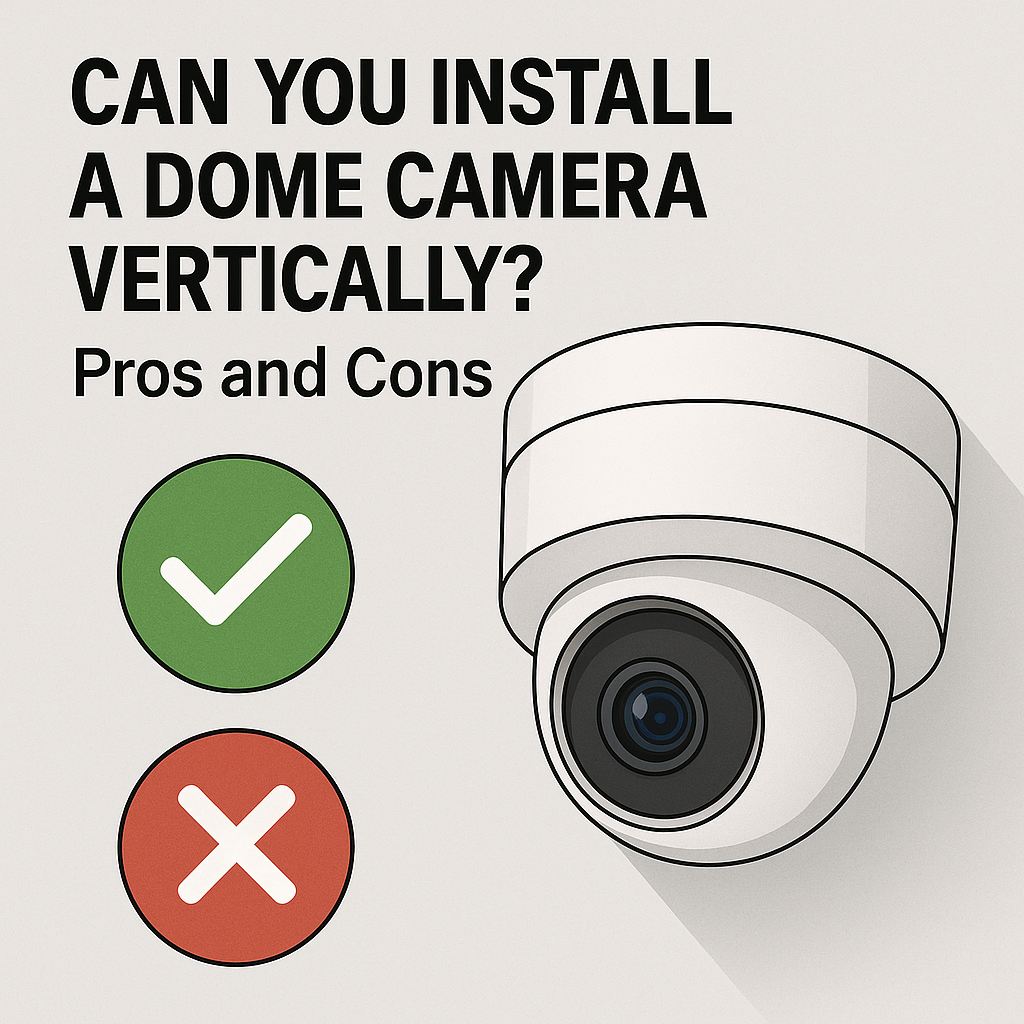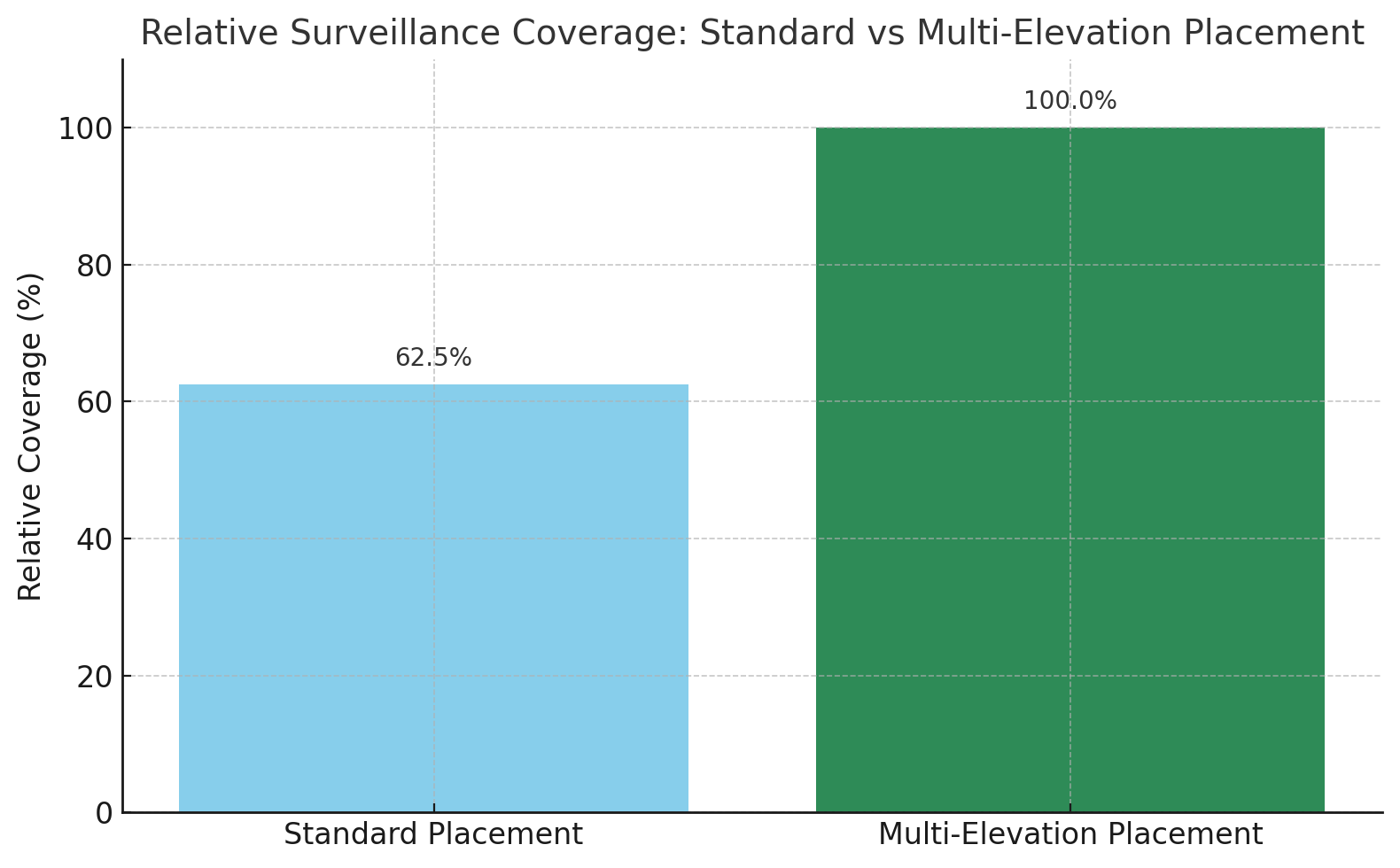Can You Install a Dome Camera Vertically? Pros & Cons Explained

- Info and Tips
Can You Install a Dome Camera Vertically? Pros and Cons
Most security cameras are designed for ceiling mounting, but what if you need to install a dome camera vertically on a wall? While this setup is possible, it comes with advantages and challenges.
In this guide, we’ll explore whether vertical installation is a good choice.
Pros of Installing a Dome Camera Vertically
Here’s why you should install a dome camera vertically,
Enhanced Field of View
Installing a dome camera vertically allows it to cover a wider vertical angle, especially useful in stairwells, hallways, or tall indoor spaces. This positioning helps capture subjects at multiple height levels — whether someone is crouching, standing, or moving up and down stairs. In retail or warehouse environments, it also improves visibility over tall shelves or equipment.
A vertical mount ensures the camera’s lens can take full advantage of its optical range, eliminating blind spots that might occur with flat ceiling mounts.
A study on CCTV coverage using 3D spatial analysis revealed that adding cameras at different elevations can improve surveillance coverage by approximately 60%. However, as the height of the monitored object increases, the coverage significantly decreases, underscoring the importance of strategic camera placement .

Better Coverage for Narrow Areas
Vertical installation is ideal for monitoring narrow spaces like corridors, entryways, or side alleys. When dome cameras are mounted vertically, their field of view stretches along the hallway’s length, giving you clearer visibility from one end to the other.
Compared to horizontal ceiling mounts, this placement aligns better with the layout of such areas. As a result, movement is captured in a more linear and focused way, reducing the chances of someone slipping through unnoticed. It’s especially helpful in office buildings, apartment complexes, and backdoor entries where space is tight and continuous coverage is critical.
Discreet and Tamper-Resistant Placement
Mounting a dome camera vertically often places it in a corner or higher sidewall location, making it harder for intruders or vandals to notice and reach. Dome cameras already have tamper-resistant housings, but when installed vertically, they’re even less accessible.
This not only preserves the integrity of the camera but also helps it blend into the environment better—especially in customer-facing areas. A camera that’s less obvious is less likely to be avoided or damaged. This strategic positioning can deter criminal behavior while ensuring the surveillance system remains functional and undisturbed.
Optimized Night Vision and Motion Detection
Vertical mounting can improve how motion is detected and how infrared (IR) night vision performs. Since the camera faces more directly along a subject’s path, it minimizes sudden angle changes that can cause false triggers.
IR LEDs also project light more efficiently when the camera’s focus is aligned with the direction of movement. This leads to clearer night-time footage and more accurate detection.
In places like garages, side entrances, and driveways, a vertically mounted dome camera can better capture license plates or faces even in low light, offering better performance compared to ceiling installations.
Flexible Mounting Options Indoors and Outdoors
Wall mounting dome cameras vertically opens up more installation possibilities — especially in areas where ceiling mounting isn’t feasible, like under awnings, on columns, or on brick walls. This flexibility makes it easier to choose a location based on optimal surveillance coverage rather than structural limitations.
Whether it’s protecting a front porch, monitoring a loading dock, or overseeing a narrow hallway, vertical placement gives you more freedom to adapt the camera to real-world needs. This versatility is particularly useful for both homeowners and business owners looking to maximize protection without compromising on aesthetics or functionality.
Cons of Installing a Dome Camera Vertically
Vertical mounting is useful, but it also has limitations.
Image Distortion
When a dome camera is mounted vertically on a wall, the viewing angle may not be as natural as it would be from a ceiling. Depending on the tilt and how the camera is positioned inside the dome, the footage can appear slanted or off-balance.
You might end up with distorted images where objects look stretched, and it may be harder to capture faces at eye level. This can reduce the effectiveness of your footage, especially in areas where detail is important for identification or evidence.
Limited Adjustment Range
Most dome cameras allow some level of lens adjustment inside the housing, but they’re not always designed for extreme angles. When mounted on a wall, you might find the internal gimbal or lens doesn’t rotate enough to cover the area you want.
To reposition it, you may have to open the dome, adjust the lens manually, and test the view multiple times. This adds effort and can be frustrating, especially if you’re not experienced with camera installation.
More Complicated Installation Process
Wall installations often take more time and planning compared to ceiling setups. You’ll need to make sure the camera is level, use stronger anchors, and possibly adjust your drilling method depending on the wall material (brick, drywall, etc.).
In some cases, you may also need a special mounting bracket for the dome to sit flush on the wall. If not done right, the camera may tilt, vibrate, or even fall over time. This can compromise both security and the camera’s lifespan.
Conclusion
Mounting a dome camera vertically can work well in many cases, especially for covering doors or hallways. It can also make the camera harder to reach or tamper with. However, you might face issues like limited view angles or blurry images if it’s not set up right.
To avoid problems, use a wide-angle or PTZ camera, adjust the lens carefully, and choose a strong mount. Always test the view before finishing the install to make sure it covers what you need.
FAQs
1. Can dome cameras be mounted on a wall?
Yes, dome cameras can be mounted vertically on a wall. While they’re usually designed for ceilings, you can still install them on walls with a bit of adjustment. Just make sure the lens is aimed correctly for the view you need.
2. What are the downsides of dome cameras?
Dome cameras can be harder to adjust once installed, and changing their direction might need a full reinstallation. They’re also not very noticeable, so they don’t scare off intruders as easily. Some may also struggle with night vision if the infrared light bounces off nearby surfaces.
3. Can dome cameras turn or rotate?
Yes, most dome cameras can rotate inside their dome cover. Many offer full 360° coverage, especially if they’re PTZ (Pan-Tilt-Zoom) models. They move quietly and are great for covering large spaces like halls or open rooms.
4. What’s the best height to install dome cameras?
Mounting them around 7 to 9 feet high works best. That way, the camera is out of reach but still close enough to capture clear images of faces and important details.
5. Which is better, dome or bullet cameras?
It depends on where and how you use them. Dome cameras are more hidden and offer wide coverage, making them great for indoor use or areas where you want a clean look. Bullet cameras are easier to spot and work better for long-range views outdoors because they act as a strong visual deterrent.